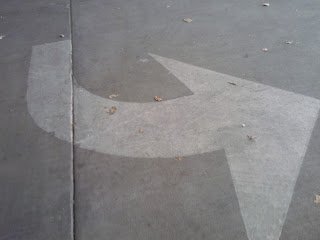These first two arrow pictures, an iPod shuffle's 'play, forward and backward' arrows and the arrow of a compass indicating 'north' were the easiest to find, I didn't even have to leave my room! It's amazing if you think about it. For instance, on any standard 'music playing device', you have up to five arrows(similar to what Phil Patton pointed out in his article, Setting Sights at the Arrow), Thats crazy!!! And how would you have known unless you looked? Same as my compass, we've all seen the arrow to indicate north, but has anyone really given any thought to the meaning of the arrow? We seem to instinctively know it's meaning but none of us seem to really reflect on 'the arrow'. Interesting.
This Exit Sign Arrow, was a random shot I took leaving Taylor Hall on my way to lunch. Here again, direction is indicated through the simpleness of the arrow. It's meaning is instantly recognizable and obvious, allowing us the know how to find the 'exit'.
All five Images above were taken out front of Taylor hall. From 'one way' to 'parking' to 'time' all contain arrows in some form. A "one way" signifier by itself means literally nothing to the viewer without the proper "signified", the arrow. How would anyone know(in some cases) which was the "one way" if it was just the text? Putting arrows for parking saves the amount of material used for signs by spreading meaning through a single sign to multiple spaces. As for time, who isn't familiar with the hands of a time piece? Without those hands(arrows) you would not be able to gauge the time rendering any watch or clock useless.
The above five are all necessary for conveying specific instructions on where to find something, or how something is to be used. Meanings derived from these mechanisms are easy to comprehend and cannot be misconstrued. The arrows help reinforce, what might be considered obvious. I believe I found all of these between the Drury Inn at North Campus and the Flagstaff Christian Church before Downtown Flagstaff.
The above two are located at and in the Drury Inn and both are relating to mechanical doorways, an automated door and an elevator. Both arrows indicate what we acknowledge as 'up'. While immediately obvious at the entrance of an elevator to mean, "going up", the arrow above that one is unclear as to why an automatic door should have an 'up' arrow....?
The remaining five were all found north of campus, between Butler and downtown. All five, in each form they come were used to indicate position or direction on top of or under the concrete. Obviously this can be very important depending on circumstance. When we drive our cars around, it's important to know which way our lane is turning so that we do not end up in a collision. Arrows show you where to turn, where you are, where you will be, whats ahead, below, up, or anywhere. And as stated in the Article, they are everywhere. If you are looking you cannot miss them. The meaning of the arrow has been ingrained into our very culture(s). And has been around longer than any of us and will be around long after we're gone. The arrow is an amazing tool when you get down to it.




















No comments:
Post a Comment